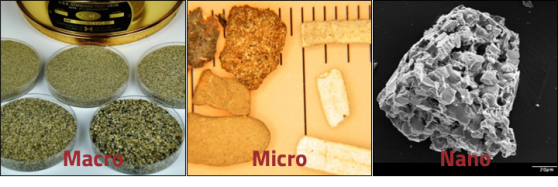Summary of Produced Sand Properties - Macro vs. Micro (B-FSM-021)

The past nine articles (B-FSM-012 to -020) have covered the various physical, mineralogical, and chemical properties of produced solids. This has been a wide-ranging overview of most every property that can be measured with sand, however in most cases not all properties are needed to design a Facilities Sand Management (FSM) system. With availability of relatively simple laboratory equipment we can measure the macro, micro, and even the nano properties of produced solids. But the goal isn’t the properties of these particles, the goal is to design a system to handle solids in oil & gas facilities.
Given the constraints of normal operations – i.e. limits on budget, time, and manpower – what are the most important properties to measure? What are the key properties for FSM design?
- Particle Size Distribution
- The most important property to measure
- Used to calculate separation efficiency and particle transport
- In absence of measurement use the following mean size as an estimate: 125 µm for natural produced solids 400 µm for artificial produced solids
- Solids Concentration
- Not a property of the solids, but of the flow stream – however critical to design
- Can vary widely from site to site, and across production profile
- Natural solids: Use 100 ppmw for steady-state production, and up to 1000 ppmw for step-changes like water breakthrough, completion failure, or rapid-change in flow
- Proppant flow-back with artificial solids: use 5000 ppmw for initial (first 1-2 days) production, dropping to 1000 ppmw for days 3-5, and 100 ppmw >5 days
- Apparent Density
- Used to calculate particle transport, solid-liquid separability, and mass-volume conversion
- As an estimate use 2650 kg/m³ for natural solids and 2800 kg/m³ for artificial solids
- Volume Fraction
- Used mass-volume conversions in collection, dewatering, and transport
- As an estimate use 0.62 volume packing fraction (both natural and artificial solids)
This will be the last article published in 2017 in this ongoing series on Facilities Sand Management. The series will continue in 2018, and start with Calculations and Conversions needed for FSM design.
References:
- Rawlins, C.H., Hewett, T.H. “A Comparison of Methodologies for Handling Produced Sand and Solids to Achieve Sustainable Hydrocarbon Production”, paper 107690, presented at the European Formation Damage Conference, Scheveningen, The Netherlands, 30 May – 1 June, 2007.
